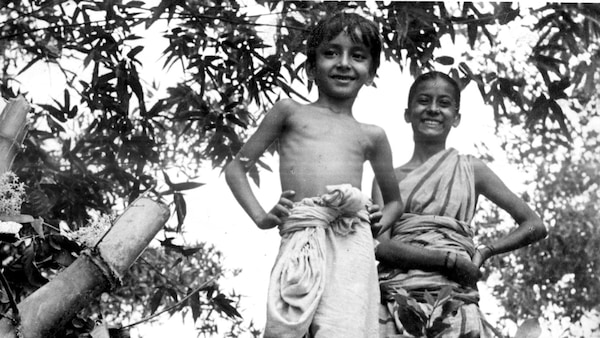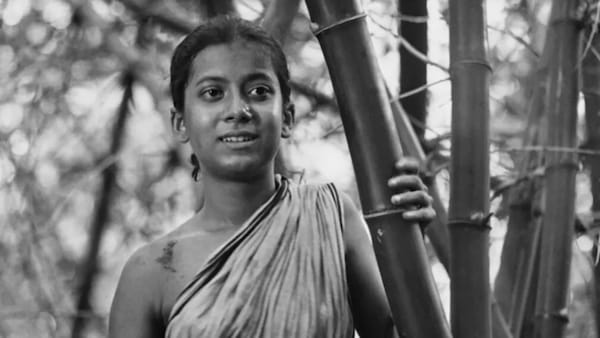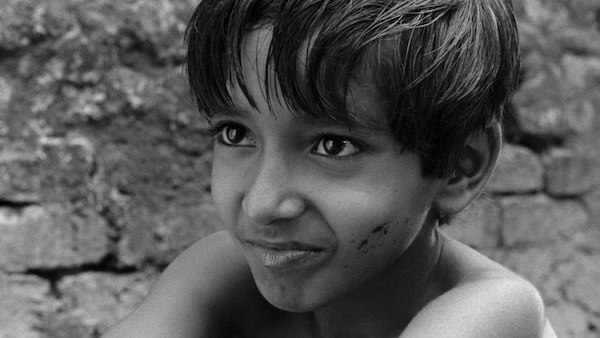The Epiphany Of Wonder: Celebrating 70 Years Of Satyajit Ray’s Pather Panchali
Seventy years after it was released, Ray's Song of the Little Road continues to lead us towards a greater understanding of the beauty of life, writes KE Priyamvada in a new column for OTTplay.

Last Updated: 12.50 PM, Jun 22, 2025
WHEN I WAS A CHILD, I remember seeing two children running across a field of kaash phool (wild sugarcane) in rural Bengal. Apu, a young boy wearing a tinsel crown, and his older sister Durga, draped in a simple saree, were running between the feathery white plumes of windblown grass to see a novelty passing their village — a train chugging by, its steam engine’s black smoke marking the sky with its intruding presence. It is an unforgettable memory that is the essence of pure cinema from Satyajit Ray’s first film and cinematic masterpiece Pather Panchali (Song of the Little Road).
This year we celebrate 70 years of Pather Panchali. Released in 1955, and recipient of the ‘Best Human Document’ award at the 1956 Cannes Film Festival, Satyajit Ray’s sensitively filmed version of the 1929 novel, written in Bengali by Bibhutibhushan Bandyopadhyay, remains an outstanding work of cinematic vision and empathy. Incidentally, another of Ray’s films Aranyer Din Ratri (Days and Nights in the Forest, 1970) was restored and screened at the Cannes Film Festival this year, 55 years after its release, to a standing ovation.

During my college years, I was able to see all three parts of the ‘Apu Trilogy’ at different times, and then had the good fortune of viewing Pather Panchali, Aparajito (1956) and Apur Sansar/The World of Apu (1959) in continuous sequence, in the span of a single day, at a screening in Delhi. The moment in Pather Panchali when the father Harihar Roy (played by Kanu Banerjee) comes home to his impoverished family in their village, with a saree for his daughter Durga, only to learn that she has passed away from a fever, moved me to tears. The heart-wrenching soundtrack (composed by Pandit Ravi Shankar), played on the tar shehnai at this moment in the film, enhances the moment of pure grief as the parents Harihar and Sarbajaya (movingly portrayed by Karuna Banerjee) mourn the loss of their lively daughter.
But let us return to the beginning. Satyajit Ray had wanted to make a film based on Pather Panchali after he had first read the novel in 1944 and created illustrations for an abridged version, when he was working as a graphic designer in Calcutta. Ray wrote a series of notes and a storyboard for his vision of the film. In Ray’s book of film criticism Our Films, Their Films (1976) he writes that he modified the story to focus on some key events, and also sought permission from Bibhutibhushan Bandyopadhyay’s widow to adapt the novel to screen, as the author had passed away in 1950.
Satyajit Ray struggled financially to make the film, even selling his collection of gramophone records to fund it. His wife Bijoya sold her jewellery, and the West Bengal government finally granted a loan for its completion, sanctioning the expenditure for ‘roads improvement’ , misunderstanding the title of the film as being a documentary on rural development!

Pather Panchali is centred on a family that lives in a dilapidated hut, in a village called Nischindipur in Bengal. The family members are Harihar Roy, a poor Brahmin; his wife Sarbajaya; their children Durga and Apu; and Indir Thakrun, an elderly relative of Harihar. Though the film depicts the family’s poverty, it does so with empathy and shows their celebration of the little joys of life with a compassionate gaze. The dignity of the characters, the childlike wonder that Apu (naturally performed by Subir Banerjee) possesses, and Durga’s sprightly nature and love for her family members engage the viewer in this gently paced film. The deaths of Indir Thakrun (an outstanding turn by Chunibala Devi) and Durga (portrayed as a young child by Runki Banerjee and as a teenager by Uma Dasgupta) during the course of the film are poignant moments that reveal the transience and fragility of life. The film ends with Harihar, Sarbajaya and Apu leaving Nischindipur for Benares, where the initial part of the next film in the Apu trilogy, Aparajito (The Unvanquished) is set.
Pather Panchali was first screened at the Museum of Modern Art in New York on 3 May 1955. It was released in Kolkata in August of the same year. Prime Minister Jawaharlal Nehru saw the film and approved its being sent to Cannes. Acclaimed by critics and filmmakers around the world, Pather Panchali has had a huge impact on Indian parallel cinema as well as introduced many film lovers worldwide to an unforgettable cinematic experience.

Ray, an avid film buff, was influenced by the cinematic vision of the Italian neorealist director Vittorio de Sica, particularly his film Bicycle Thieves (1948), and the work of Jean Renoir, whom Ray met when Renoir came to India to film The River (1951). After Pather Panchali, Ray went on to establish himself as one of India’s finest filmmakers with a body of work that continues to be viewed by lovers of cinema as well as studied and analysed by film researchers and critics even today. In 1992, the Academy of Motion Picture Arts and Sciences awarded Ray an Honorary Oscar for Lifetime Achievement. Frail and bedridden, Ray accepted the award in a recorded speech, calling it ‘the best achievement of my movie-making career’. Ray’s cinematic legacy transcends awards and accolades. He showed the world how life could be portrayed realistically and with compassion.

In 2015, to mark the 60th anniversary of Pather Panchali, the Criterion Collection released a restored version of the Apu Trilogy, resurrected from damaged prints and negatives after a fire nearly destroyed them in the 1990s. The restoration, undertaken by the Academy Film Archive in collaboration with L’Immagine Ritrovata in Bologna, ensured that Ray’s masterpiece continues to inspire audiences today.
As we commemorate the 70th anniversary of Pather Panchali, we are reminded not only of the film’s historic impact but also of the enduring relevance of Ray’s vision. In a world increasingly drawn to over-the-top spectacle, Ray’s meditative, compassionate cinema remains a powerful antidote — a quiet reminder of the dignity of ordinary lives and the transcendent power of storytelling.
Pather Panchali is an experience that has significantly impacted Indian cinema and continues to touch the hearts of viewers across the globe. Seventy years later, this Song of the Little Road continues to lead us towards a greater understanding of the beauty of life and what the film writer Darius Cooper has described as ‘the epiphany of wonder’.
***
KE Priyamvada is an editor and author. She was the winner of the television quiz show BBC Mastermind India 2000. You can find out about her books, and more, on her website.
